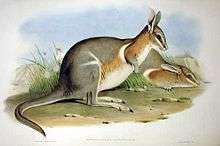Crescent nail-tail wallaby
| Crescent nail-tail wallaby[1] Temporal range: Recent | |
|---|---|
 | |
| Scientific classification | |
| Kingdom: | Animalia |
| Phylum: | Chordata |
| Class: | Mammalia |
| Order: | Diprotodontia |
| Family: | Macropodidae |
| Genus: | Onychogalea |
| Species: | O. lunata |
| Binomial name | |
| Onychogalea lunata (Gould, 1841) | |
The crescent nail-tail wallaby (Onychogalea lunata) was a nail-tail wallaby that lived in the woodlands and scrubs of the west and centre of Australia. It had silky fur and, like other nail-tail wallabies, had a horny spur at the tip of its tail. It was the size of a hare and was the smallest nail-tail wallaby at about 15 inches tall.[3] When it was chased, it tended to seek refuge in a hollow tree. It entered at the bottom, clambered up and appeared at an opening high above. While running, the species held its forelimbs awkwardly and moved them in a rotary motion.[3]
The wallaby remained common, even in agricultural districts in the south-west of Western Australia, until about 1900. It had begun a steep decline by 1908, when the last wallaby was caught in the area. The last specimen of this wallaby to be collected alive was caught in a dingo trap on the Nullarbor Plain in 1927 or 1928. W.A. Mills sent it to Taronga Zoo in Sydney and the animal ended up in the Australian Museum. The species survived in the more arid parts of its distribution until the 1950s, and it is thought that it became extinct at about 1956, probably because of the spread of the red fox.
References
- ↑ Groves, C.P. (2005). Wilson, D.E.; Reeder, D.M., eds. Mammal Species of the World: A Taxonomic and Geographic Reference (3rd ed.). Baltimore: Johns Hopkins University Press. OCLC 62265494. ISBN 0-801-88221-4.
- ↑ Burbidge, A. & Johnson, K. (2008). "Onychogalea lunata". IUCN Red List of Threatened Species. Version 2008. International Union for Conservation of Nature. Retrieved 28 December 2008. Database entry includes justification for why this species is listed as extinct
- 1 2 Ellis, Richard (2004). No Turning Back: The Life and Death of Animal Species. New York: Harper Perennial. p. 229. ISBN 0-06-055804-0.
- A Gap in Nature by Tim Flannery and Peter Schouten (2001), published by William Heinemann
